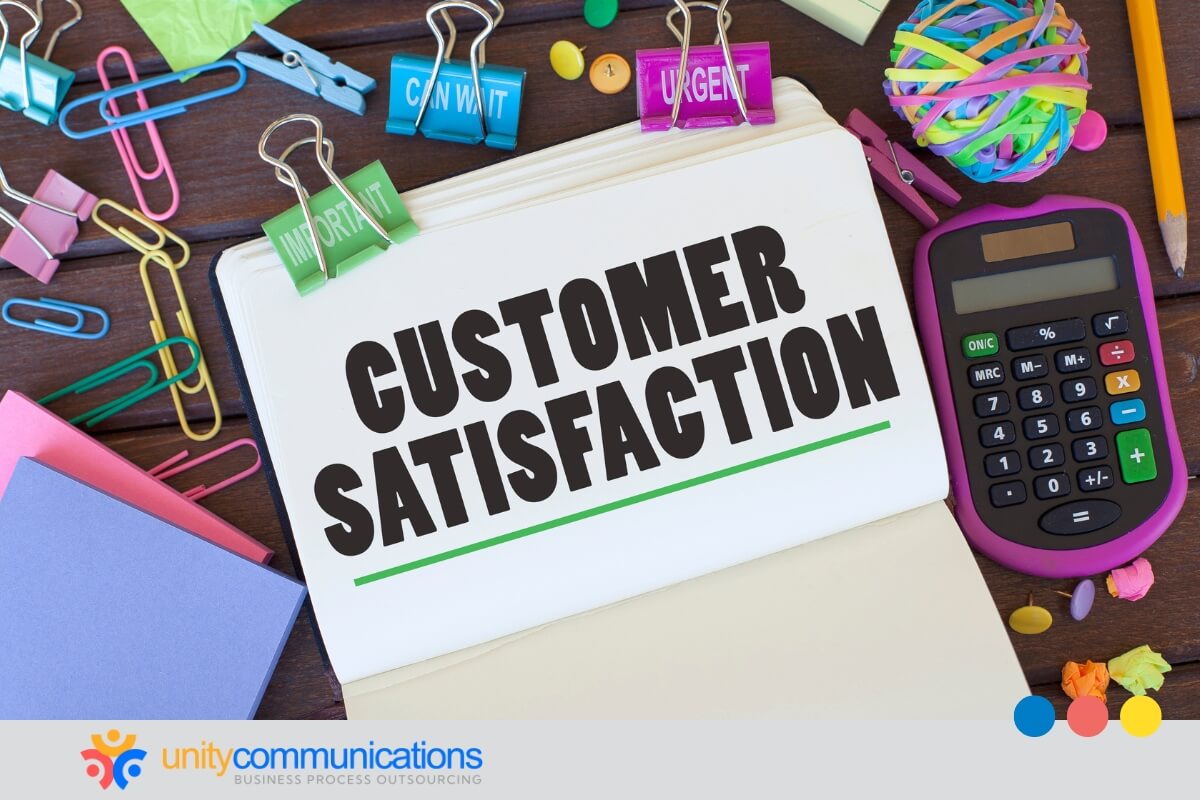Table of Contents
Lead qualification powered by artificial intelligence (AI) offers small and medium-sized businesses (SMBs) a more innovative approach to managing prospects and minimizing missed opportunities. With AI agents integrated into business process outsourcing (BPO), tasks move faster and more consistently.
An AI virtual receptionist in lead qualification strengthens response times, streamlines handoffs, and improves sales pipeline quality.
This guide explains how AI virtual receptionists work, where they fit in your sales funnel, provides a practical implementation playbook, outlines key point indicators (KPIs) to track, identifies common pitfalls, and offers guidance on selecting the right BPO partner.
Why use AI virtual receptionists in lead qualification?

For SMBs, capturing and managing leads efficiently can be the difference between steady growth and missed opportunities. AI virtual receptionists in lead qualification automate intake, scoring, and routing, speeding up follow-ups and ensuring consistent responses.
The global AI in sales market size was valued at $24.64 billion in 2024 and could reach $145.12 billion by 2033. This indicates that businesses are increasingly investing in intelligent tools to improve sales outcomes and operational efficiency. It also highlights the growing relevance of AI virtual receptionists in everyday lead management.
Whether managing inbound interest or nurturing prospects over time, the AI virtual receptionist for lead qualification can help you handle these tasks more accurately and quickly, giving your team more capacity to focus on closing deals.
What an AI virtual receptionist is and how it works
The AI virtual receptionist in lead qualification is an intelligent system that acts as a first point of contact for incoming leads. By integrating with your existing customer management and communication tools, it can automate many tasks that require human intervention. Here’s what it can do for you:
- Answer and categorize incoming inquiries across phone, chat, and text.
- Gather and verify lead information using smart forms and structured data.
- Filter spam and remove duplicate entries to reduce pipeline noise.
- Score leads using rules or machine learning (ML) to prioritize high-value prospects.
- Schedule follow-ups or meetings with fair rotation and availability buffers.
- Maintain consent records and compliance logs for secure data handling.
- Trigger marketing campaigns based on lead behavior through automation tools.
- Analyze conversation patterns to identify high-intent prospects and churn risks.
- Report real-time analytics on lead engagement and pipeline status.
- Support multiple languages to engage diverse prospects.
- Recommend next-best actions using predictive insights.
- Adapt scripts and responses based on historical engagement patterns.
- Categorize leads by region, industry, or company size for targeted outreach.
- Flag and consolidate duplicate leads across channels to keep customer relationship management (CRM) clean.
- Generate insights on peak engagement times to optimize follow-ups.
The AI virtual receptionist for lead qualification reduces errors, saves time, and facilitates prompt lead follow-up, keeping interactions consistent while your sales team focuses on closing priority deals.
Why lead qualification matters for SMBs
Every lead counts. Proper lead qualification means your sales team focuses on prospects with the highest potential, rather than wasting time on unverified or low-value contacts. BPO for small businesses is increasingly incorporating AI systems to enhance lead management without expanding headcount.
Around 96% research independently before talking to a human sales representative. If your team isn’t acting quickly and effectively, potential customers might move on before you can connect.
Lead qualification helps identify which prospects are ready to engage and which require nurturing, allowing you to allocate resources efficiently. Integrating AI in this process provides speed, consistency, and data-driven decision-making, giving your company a business advantage.
The cost of missed leads and poor handling
Your business might miss significant revenue opportunities if leads are not adequately qualified or followed up on promptly. Using an AI virtual receptionist in lead qualification helps minimize these risks. However, understanding the stakes emphasizes the importance of timely action.
Consider the following:
- Sales reps can potentially forfeit up to 76% of qualified leads without follow-up actions, losing valuable prospects.
- Slow response times can lead to reduced customer satisfaction and increased churn.
- Leads are lost to competitors because of inconsistent follow-ups.
- Manual processes lead to increased administrative errors and duplicate efforts.
- Missed or delayed lead follow-ups can lower overall sales conversion rates and extend sales cycles.
- Inconsistent lead tracking makes it difficult to identify trends or refine marketing strategies.
- Poor handling of leads can damage your brand reputation and reduce trust among potential customers.
Additionally, only 18% of marketers consider outbound lead generation efforts to be effective in delivering valuable leads. Poorly managed outbound campaigns can waste time, money, and effort, underscoring the importance of automating qualification and routing.
Implementing AI systems reduces reliance on inconsistent manual processes and helps your team focus on the most promising prospects.
Key benefits of using AI for lead qualification
Integrating AI into lead qualification processes provides measurable benefits for your business. Automating repetitive tasks and optimizing lead management can increase efficiency, enhance customer engagement, and boost revenue potential.
Key advantages of using the AI virtual receptionist for lead qualification include:
- Faster follow-up times across channels to engage leads promptly
- Accurate lead scoring using AI and ML
- Reduced administrative workload for sales and marketing teams
- Consistent handling of sensitive data with compliance checks
- Prioritized resource allocation for high-value leads
- Seamless integration with AI and BPO strategies
- Personalized outreach tailored to prospect behavior
- Comprehensive multi-channel engagement tracking
- Dynamic nurturing workflows triggered by prospect activity
- Optimized lead routing based on real-time sales rep availability
- Insights for cross-sell, upsell, and referral opportunities
- Automated reminders to prevent missed leads
The global intelligent virtual assistant market could hit $18.91 billion by 2032. This highlights how businesses increasingly use AI tools to streamline lead qualification and customer management.
These benefits save time and help your SMB compete with larger firms in lead management. AI capabilities let you respond to prospects quickly, efficiently, and intelligently, improving lead handling and customer engagement.
How do you implement AI-powered lead qualification?
Implement AI-powered lead qualification by combining strategy, automation, and integration. The process begins with defined rules, adaptive intake forms, and automated verification that the AI virtual receptionist handling lead qualification executes consistently.
From there, AI scores leads, routes them, and schedules follow-ups based on urgency, fit, and rep availability. Integration with your CRM and marketing tools keeps records accurate while supporting channel compliance.
This connected system enables your sales team to focus on high-value conversations while automating repetitive tasks.
The following sections summarize essential frameworks and practical applications to show how this works:
1. Set clear goals and choose a qualification framework
Your qualification process starts by defining what a “good lead” means for your business. Without this, the AI virtual receptionist supporting lead qualification cannot be prioritized effectively. You can adopt the following industry-tested models and adjust them to match your sales cycle:
- Budget, authority, need, timing (BANT). This framework evaluates funds, authority, need, and timing, while AI flags leads that fit.
- Challenges, authority, money, prioritization (CHAMP). This model weighs challenges, authority, money, and priorities, with AI surfacing urgent leads.
- Metrics, economic buyer, decision criteria, decision process, identify pain, champion (MEDDIC). This framework encompasses metrics, buyers, decisions, pain points, and champions, with AI mapping each.
The following ways strengthen frameworks with AI:
- Train prompts to uncover challenges conversationally, not as rigid scripts.
- Calibrate scoring with historical win rates.
- Exclude poor-fit leads with negative criteria.
- Segment frameworks by industry, region, or product line.
- Teach AI to interpret jargon to spot intent in technical contexts.
- Adjust thresholds seasonally (e.g., end-of-year budgets).
- Embed rep feedback loops so AI improves over time.
- Automate alerts when multiple stakeholders from one account engage.
Framework choice sometimes involves a cost-benefit analysis of outsourcing, especially when balancing in-house bandwidth against external AI-powered support.
2. Design smart intake forms with branching questions
Intake forms mark the first prospect interaction. With AI, they adjust to responses instead of fixed questions. The AI-powered receptionist handling lead qualification makes this step sharper and more effective.
Practical ideas for smart intake design include:
- Start with basic fields, then branch deeper if conditions match.
- Add industry-specific fields to build credibility.
- Capture channel preferences so AI tags outreach by email, voice, or chat.
- Provide optional fields, allowing AI to infer missing data using probability models.
- Use sliders for urgency or budget ranges instead of simple checkboxes.
- Track form completion time as a signal of engagement.
- Save partial submissions and let AI follow up for missing details.
- Map responses directly into scoring models for faster routing.
- Run variations across campaigns to identify better-performing questions.
These adaptive forms keep prospects engaged and yield structured data for your team.
3. Verify contacts and filter spam or duplicate entries
Data accuracy is critical. Verification prevents wasted time, while filtering protects your CRM from clutter.
The following are smart verification practices:
- Validate emails against domain registries to spot disposable accounts.
- Check phone numbers against regional databases.
- Use internal protocol (IP) checks to flag mismatched locations.
- Detect duplicates across campaigns and merge them.
- Score data credibility so reps focus on validated contacts.
- Train spam filters to learn from repeated junk patterns.
- Scan text for irrelevant links or repetitive characters.
- Re-verify older leads periodically to maintain quality.
- Apply fuzzy matching to prevent typos from creating duplicates.
This keeps your pipeline clean and strengthens the AI virtual receptionist in lead qualification with reliable data.
4. Score leads using rules or learning models and set routing
Scoring assigns value, while routing connects prospects to the right rep. Done well, this accelerates conversion.
Ways to strengthen scoring and routing include:
- Award points for job title, company size, and buying signals.
- Detect urgency through keywords or behaviors.
- Assign high-value leads to senior reps.
- Apply score decay when engagement fades.
- Route based on product expertise, geography, or vertical.
- Balance distribution to avoid overload.
- Train models on closed-won deals for accuracy.
- Combine form data with inbound engagement.
- Adjust routing dynamically based on rep availability.
With the AI virtual receptionist dealing with lead qualification, scoring becomes faster, fairer, and highly adaptable.
5. Connect your customer management and marketing tools
Integration is the backbone of AI-powered qualification. Without connected systems, efficiency drops. Research reveals 91% of growing companies with ten or more employees rely on a CRM. This highlights how connections matter for effectively capturing, scoring, and routing leads.
Fresh integration tactics include:
- Sync captured data into CRM records automatically.
- Trigger campaigns when a lead reaches score thresholds.
- Track activity across chat, voice, and email in one dashboard.
- Share updates instantly across sales and marketing teams.
- Attach call transcripts directly to CRM notes.
- Utilize application programming interfaces (APIs) to integrate niche tools into your workflow.
- Merge CRM data with AI scoring insights in dashboards.
- Test integration paths in sandbox mode before rollout.
Outsourcing and artificial intelligence meet here, with partners offering tech and support. An intelligent receptionist system for lead qualification keeps integrations efficient and scalable for SMBs.
6. Schedule only qualified leads with fair rotation and buffers
Meetings should focus on strong leads while maintaining a balanced workload. Scheduling approaches include:
- Add buffers between calls to reduce burnout.
- Rotate meetings evenly among reps.
- Hold back low-quality leads until they have been nurtured further.
- Prioritize scheduling by urgency and lead score.
- Sync calendars to avoid double booking.
- Offer time slots across different time zones.
- Cancel meetings automatically when the qualification drops.
- Notify reps instantly when meetings are set.
Here, the AI virtual receptionist for lead qualification enforces scheduling rules seamlessly.
7. Capture leads across voice, chat, and text with structured data
Prospects demand flexibility. They want options across channels, underscoring the need for an omnichannel intake approach.
Here are ways to capture leads effectively:
- Standardize data fields across every channel.
- Map chat and call notes directly into CRM fields.
- Enable click-to-text for fast mobile inquiries.
- Recognize voice intent to capture urgency cues.
- Tag communication preferences for future outreach.
- Analyze conversation tone for buying signals.
- Store transcripts securely for compliance.
- Use consistent lead IDs across all platforms.
This structured process enables the virtual AI assistant to qualify leads while keeping data organized and actionable.
8. Route high-interest leads quickly and nurture others in queues
High-interest prospects need immediate attention, while others belong in nurture tracks. Routing strategies include:
- Prioritize hot leads with direct contact from a representative.
- Place lower-scoring leads into automated nurture sequences.
- Assign decision-makers to senior reps.
- Route by market segment or product expertise.
- Trigger reminders when inactivity stretches too long.
- Build tiered queues for hot, warm, and cold leads.
- Fast-track prospects showing urgency.
This balance accelerates conversion without neglecting long-term opportunities.
9. Follow rules for consent and secure handling of personal data
Compliance is non-negotiable. Mishandling data risks fines and erosion of trust. Practice the following strong compliance strategies:
- Use clear opt-in checkboxes for consent.
- Store consent timestamps in audit logs.
- Encrypt all stored data to block unauthorized access.
- Restrict field-level access to sensitive records.
- Conduct periodic data audits.
- Comply with industry regulations and regional laws.
- Archive records after retention limits.
- Train AI to detect missing consent.
Compliance is especially vital in outsourced operations, underlining the importance of data security in financial BPO, where sensitive information is exchanged.
10. Measure performance and improve lead handling over time
AI systems thrive on feedback. Continuous refinement drives accuracy. Performance improvement tactics include the following:
- Track conversion rates per framework.
- Compare AI lead scores with deal outcomes.
- Monitor time from inquiry to first contact.
- Gather rep feedback on AI-qualified leads.
- Run A/B tests on intake variations.
- Measure performance by channel to prioritize high-return ones.
- Refine routing rules monthly with benchmarks.
- Adjust scoring weights based on seasonal shifts.
This cycle enables the AI virtual receptionist for lead qualification to continually improve, providing your team with higher-quality leads.
What are the key metrics to measure ROI?

You measure AI-driven lead qualification by tracking speed, conversions, costs, and the impact on customers. The AI-powered virtual receptionist used for lead qualification provides structured metrics, making performance measurable across various stages.
In particular, response speed shows how fast prospects are engaged. Conversions from qualified leads reflect the accuracy of AI scoring. Cost per lead before and after adoption highlights efficiency. Customer satisfaction at the first point of contact measures the quality of the experience. Tracking return on investment (ROI) and long-term growth connects short-term gains with sustained success.
The following sections break down these key performance indicators (KPIs) in detail:
1. Response speed and lead follow-up times
Prospects value prompt responses, and delays can motivate them to consider competitors. Quick responses signal reliability, keeping leads active while reducing the risk of losing them to competitors.
The following are ways to improve speed and follow-up:
- Track the average time from inquiry to first contact to identify gaps in responsiveness.
- Send automated acknowledgment messages so prospects feel attended to immediately.
- Route high-priority leads to available reps without delay to maximize conversion potential.
- Use AI notifications for leads that remain uncontacted beyond set thresholds.
- Measure follow-up consistency across communication channels.
- Benchmark your response times against those of competitors or industry standards to stay competitive.
- Distribute leads evenly to prevent bottlenecks caused by overloaded representatives.
- Monitor dropout rates linked to slow responses and refine workflows accordingly.
- Automate reminders for reps when follow-ups are pending.
- Record peak inquiry times to adjust staffing or AI-assisted coverage.
- Analyze past interactions to identify recurring delays and refine processes proactively.
This structured follow-up system enables the AI virtual receptionist to manage lead qualification and maintain quick, reliable engagement, keeping your pipeline active and responsive.
2. Sales conversions from qualified leads
Your ability to convert leads into customers depends on accurate prioritization. Research shows that 83% of AI-assisted sales teams experienced revenue growth in 2024, compared with 66% of teams without AI, demonstrating how automation and precise scoring can enhance performance.
An AI assistant helps you focus on high-value prospects while minimizing time spent on low-potential contacts through the following tactics:
- Analyze past win rates to refine scoring for better targeting and prioritization.
- Assign high-value leads to reps with relevant expertise or industry knowledge.
- Leverage lead behavior data, such as downloads or clicks, to guide outreach timing.
- Utilize AI-driven insights to tailor messaging to address prospect pain points.
- Monitor engagement across channels to prioritize active prospects.
- Set predictive alerts for leads showing buying signals or urgency cues.
- Route leads by product fit, vertical, or region for efficient handling.
- Track conversion ratios by rep and team to balance workloads.
- Test follow-up scripts using A/B experiments to identify more effective approaches.
- Maintain feedback loops to ensure AI continuously improves scoring.
- Detect pipeline bottlenecks and adjust assignments to prevent delays.
With an AI virtual receptionist for managing lead qualification, this focused approach increases conversions by connecting the right leads with the right reps at the optimal time.
3. Cost per lead before and after AI adoption
Measuring cost per lead helps you gauge the financial impact of AI in lead qualification. Comparing costs before and after adoption highlights efficiency gains, resource optimization, and more predictable budgeting.
Lower costs per lead result from faster qualification, improved targeting, higher accuracy, and reduced manual effort. AI delivers real-time insights, letting you allocate marketing and sales budgets efficiently while minimizing wasted spend.
The following are ways to optimize and measure cost per lead:
- Track total lead acquisition costs across channels and campaigns.
- Compare the labor hours spent manually qualifying leads versus those spent using AI-assisted qualification.
- Measure campaign ROI by linking spend to qualified lead generation.
- Calculate savings from reduced follow-up delays and duplicate entries.
- Factor in efficiencies from automated lead routing and scoring.
- Monitor costs of external BPO support versus in-house resources with AI.
- Adjust marketing spend based on AI-identified high-converting segments.
- Utilize predictive analytics to forecast lead volume and allocate budgets effectively.
- Integrate CRM and marketing data to track spend per lead precisely.
- Identify low-performing campaigns and quickly reallocate resources.
- Evaluate seasonal trends to plan cost-efficient lead acquisition.
With a financial tracking system, the AI virtual receptionist can optimize lead acquisition expenses while giving your team actionable insights into campaign performance and budget allocation.
4. Customer satisfaction with first contact
First impressions matter. Prospects judge your responsiveness and professionalism from the initial interaction. A fast, accurate first touch builds trust and reduces churn. Early engagement can significantly influence long-term loyalty and increase conversion. Leveraging outsourcing strategies can enhance this process, improving customer satisfaction through call center BPO.
You can enhance first-contact satisfaction with these strategies:
- Personalize greetings based on lead source or prior interactions to make prospects feel recognized.
- Confirm and summarize prospect inquiries instantly to reduce confusion.
- Offer flexible channels (e.g., phone, chat, or email) so prospects connect on their preferred medium.
- Provide instant access to frequently asked questions (FAQs), pricing, or service details to shorten resolution times.
- Use sentiment detection to prioritize sensitive or frustrated leads for prompt attention and escalation.
- Record interactions for compliance and reference, allowing your team to follow up accurately.
- Notify reps of high-value or urgent leads in real time.
- Maintain continuity by automatically passing context from intake forms to live agents.
- Monitor first-contact resolution rates and adjust AI scripts to minimize the frequency of repeated inquiries.
- Embed AI insights into conversation flows for tailored recommendations.
This approach lets your AI virtual receptionist for lead qualification handle first-touch interactions efficiently, supporting consistency while freeing your team to focus on high-value engagement.
5. Track ROI and long-term business growth
Measuring ROI shows how AI-driven lead qualification and outsourcing drive sustainable growth. Leveraging BPO advantages offers efficiency, scalable operations, and expert support while keeping costs predictable and aligning with long-term strategy. Understanding short-term gains and strategic impacts helps your firm maximize value from AI-enabled processes.
Here are ways to monitor ROI and business growth:
- Compare revenue from AI-assisted lead handling versus manual processes to quantify financial impact.
- Track cost savings from reduced administrative work and more efficient resource allocation.
- Measure customer lifetime value for leads nurtured through outsourced processes.
- Assess sales cycle duration improvements from streamlined lead qualification.
- Monitor rep productivity and throughput using dashboards and analytics.
- Evaluate team bandwidth and capacity gains from external support.
- Benchmark market share growth and regional expansion tied to improved lead handling.
- Incorporate seasonal or campaign variations in ROI calculations for more accurate forecasting.
- Identify high-performing channels and allocate the budget accordingly.
- Track repeat business and upsell opportunities generated through consistent lead engagement.
- Collect qualitative feedback from reps and customers to inform strategic adjustments.
- Harness predictive analytics to forecast future lead quality and revenue potential, enabling proactive adjustments to your strategy.
This ROI tracking system links operational efficiency to long-term business growth, enabling you to make data-driven decisions while scaling smarter.
What are the common pitfalls and how to fix them?
AI lead qualification can face challenges such as setup complexity, data errors, and balancing automation with human judgment. You can address these by carefully integrating systems and monitoring scoring with an AI virtual receptionist overseeing lead qualification.
Proper setup ensures smooth connections with CRMs and marketing tools, while human checks identify misrouted leads or inaccurate scores. Clear communication builds customer trust, and adherence to data privacy regulations protects sensitive information.
Explore the challenges and their solutions in detail:
1. Setup and integration with business systems
Setting up an AI virtual receptionist requires smooth integration with your business systems to maintain data flow and optimize lead handling. Proper setup reduces bottlenecks and allows your sales and marketing teams to act efficiently on high-value leads.
Aligning with BPO trends and predictions enables your SMB to adopt advanced automation while maintaining operational flexibility.
Address setup and integration issues with these tactics:
- Connect AI to CRM, marketing automation, and analytics tools for real-time data sharing.
- Standardize data fields across channels to prevent mismatched or incomplete lead information.
- Map lead sources to scoring frameworks to prioritize high-potential prospects.
- Configure automated notifications for representatives when high-value leads are added to the system.
- Enable two-way syncing so that CRM updates are reflected in the AI dashboard instantly.
- Implement adaptive intake forms that adjust based on prior interactions or prospect behavior.
- Audit workflows to identify integration gaps and reduce manual handoffs.
- Train your team to interpret AI-generated insights for actionable decisions.
- Monitor integration performance and latency to avoid delays in lead routing.
- Test new features in sandbox environments before going live.
With this setup, the AI virtual receptionist can oversee lead qualification and operate efficiently, linking systems seamlessly and improving lead visibility. Proper integration lays the foundation for subsequent automation and human oversight.
2. Balance automation with human oversight
Balancing automation with human oversight is crucial to avoid errors and maintain quality in lead qualification. While AI streamlines intake, scoring, and routing, human judgment ensures that nuanced decisions, sensitive leads, and complex scenarios are handled appropriately.
Addressing BPO risks and drawbacks requires monitoring AI outputs, validating results, and keeping human oversight where needed. Your team gains faster processes without compromising accuracy or customer experience, while an AI-powered virtual receptionist automates routine tasks efficiently and minimizes errors.
You can help resolve balancing automation and oversight issues with these ideas:
- Assign reps to review high-value or flagged leads before final outreach.
- Set thresholds for automated scoring and routing to trigger human checks.
- Use dashboards to monitor AI performance and detect anomalies.
- Conduct weekly audits of AI-handled leads to confirm accuracy.
- Adjust AI rules dynamically based on feedback from reps.
- Provide scenario-based training so humans can handle exceptions effectively.
- Maintain communication loops between AI systems and your sales team.
- Rotate oversight responsibilities to prevent bias and fatigue.
- Track AI-human handoff times to optimize workflow efficiency.
- Encourage reps to log insights that refine AI models over time.
In this approach, the AI virtual receptionist automate tedious tasks in lead qualifications while human oversight maintains lead quality and reduces risk exposure.
3. Correct errors in scoring and data entry
Maintaining accurate lead data can maximize sales outcomes. Errors in scoring or misentered information can misprioritize prospects and reduce conversion potential. An AI virtual receptionist helps you catch inconsistencies early, supporting cleaner workflows.
Combining automated checks with human review reduces the risk of inaccurate data affecting decision-making. Automation in the BPO industry has accelerated the need for robust error-correction processes, ensuring AI tools enhance rather than compromise lead management quality.
Ways to help correct scoring and data entry issues include:
- Implement real-time validation for lead forms to prevent incomplete or inconsistent entries.
- Use AI-powered anomaly detection to flag unusual scores or duplicate leads.
- Compare new data against historical trends to highlight discrepancies for review.
- Train your AI models with updated datasets for higher scoring accuracy.
- Schedule routine audits to reconcile CRM data with source inputs.
- Enable automatic alerts for critical mismatches in lead information.
- Incorporate feedback loops from reps to continuously refine scoring algorithms.
- Track error rates over time to measure improvement and adjust workflows.
- Apply predictive corrections to anticipate and prevent common data entry mistakes.
- Maintain logs of adjustments for transparency and compliance.
This system lets your AI virtual receptionist for lead qualification support accurate scoring and reliable data entry while minimizing manual corrections.
4. Build customer trust with automation
Gaining customer confidence in AI virtual receptionists is vital for successful lead qualification. Many clients appreciate speed, but they also value reliability and personalization. You must demonstrate accountability and transparency when implementing AI solutions.
Using an AI virtual receptionist helps deliver consistent, reliable interactions while reinforcing trust. You can address customer trust and confidence issues through the following:
- Personalize responses to align with prospect expectations and cultural nuances.
- Provide clear explanations when AI handles decisions or recommendations.
- Allow human follow-ups for sensitive inquiries or escalations.
- Maintain transparent logs of automated interactions for accountability and integrity.
- Integrate multilingual support and culturally aware messaging.
- Regularly monitor customer feedback to identify perception gaps and continuous improvement.
- Apply best practices for managing cultural differences in BPO to facilitate effective communication among diverse teams.
- Set clear service standards and response times for AI-handled interactions.
- Educate prospects about AI capabilities and limits to build transparency.
- Encourage reps to review AI-driven recommendations before taking action.
This approach lets your team leverage AI efficiency while maintaining human-centered trust, making automation a reliable part of your lead management strategy.
5. Meet rules for data use and compliance
Handling prospect data responsibly helps maintain trust and avoid regulatory penalties. You need clear policies for consent, storage, and access while monitoring AI-assisted workflows for compliance gaps.
Data governance must align with industry regulations and regional laws, including the General Data Protection Regulation (GDPR). Integrating automation can support accuracy, but human oversight remains crucial for handling sensitive data. Transparent protocols help your team manage records and reduce risk exposure while maintaining lead quality.
Here are ways to address rules for data use and compliance issues:
- Obtain explicit consent from leads before storing or processing information.
- Maintain detailed audit trails of data access, updates, and deletions.
- Encrypt sensitive fields in CRM and communication platforms.
- Implement role-based access control to restrict who can view or modify data.
- Conduct routine compliance audits to verify adherence to regulations.
- Utilize automated alerts to detect potential data breaches or policy violations.
- Regularly train your team on evolving data protection standards.
- Implement retention policies that archive or delete outdated records in a responsible manner.
- Validate third-party integrations to maintain secure data transfer.
- Document and update procedures to reflect legal or industry changes.
Following these practices allows your team to manage prospect data responsibly, comply with regulations, maintain customer confidence, and support operational efficiency.
Why outsource AI-powered lead qualification?

Outsourcing lead qualification with AI virtual receptionists reduces manual workload while improving speed and accuracy. It automates intake, scoring, and routing, freeing your team to focus on high-value sales conversations.
This strategy reduces costs, provides 24/7 coverage without additional hires, and scales with growth. Partnering with SMB-focused third-party providers adds flexibility and expertise, while automation maintains consistency and lets your team prioritize closing high-value leads.
The global outsourcing market could exceed $1 trillion in 2025, showing how vital outsourcing has become for efficiency.
1. Cut costs by outsourcing routine lead handling
Managing lead intake and follow-ups in-house becomes expensive. Recruiting, training, and retaining staff increase overhead. Outsourcing routine tasks to an AI virtual receptionist involved in lead qualification helps you cut costs while keeping processes accurate and consistent.
You might ask what BPO is when considering cost-saving strategies. Outsourcing delegates functions to service providers with AI systems, including intake, scoring, or scheduling. This reduces operating expenses while sustaining reliable service.
Another critical distinction is outsourcing vs. offshoring. Outsourcing involves shifting work outside your business, typically to specialized providers, while offshoring relocates functions abroad for labor cost savings. With AI-powered BPO, you gain efficiency without sacrificing speed or customer experience.
Outsourcing routine lead handling reduces costs in the following ways:
- Lower staffing expenses by reducing the need for new hires.
- Eliminate overtime by allowing AI to consistently manage high-volume inquiries.
- Reduce training budgets for repetitive intake and scoring tasks.
- Minimize mistakes that waste ad spend or overlook opportunities.
- Scale operations without investing heavily in infrastructure or workforce growth.
- Pay only for the service levels you need with flexible contracts.
- Reduce turnover risk by delegating repetitive work to a team outside your core.
By outsourcing routine tasks, you keep expenses predictable and let your team focus on revenue-driving priorities.
2. Free your team to focus on closing sales
Sales teams typically spend valuable hours on repetitive tasks such as logging inquiries, qualifying low-value prospects, and managing schedules. These tasks take attention away from nurturing relationships and closing deals. An AI virtual receptionist in lead qualification automates these steps, so your reps can dedicate more time to conversions.
Understanding how outsourcing works highlights why this shift is decisive. Instead of overwhelming in-house staff with every lead, you offload repetitive tasks such as intake, scoring, and routing to third-party providers. AI technology handles initial qualification with speed and accuracy, and your team receives only high-potential prospects ready for deeper engagement.
Outsourcing helps your team focus on closing sales in the following ways:
- Pass low-value inquiries to AI, leaving top-tier prospects for your reps.
- Shorten response times, provide sales staff with warm leads faster, and enhance overall deal quality.
- Reduce burnout by eliminating repetitive intake and scheduling tasks.
- Keep pipelines clean by filtering out incomplete or duplicate submissions.
- Provide reps with accurate, prioritized lead lists daily.
- Align sales outreach with automated follow-ups handled in real time.
- Free managers from constant supervision of intake workflows.
This structure allows your people to invest energy where it matters most: building trust, tailoring proposals, and driving revenue.
3. Access 24/7 support without hiring extra staff
Round-the-clock coverage gives your business a competitive edge, especially when prospects extend beyond typical office hours. An AI virtual receptionist in lead qualification can answer questions instantly, score leads, schedule appointments, and route urgent concerns without requiring additional full-time hires.
Automating front-end lead handling lets you deliver timely engagement at any hour while controlling costs. You can:
- Capture leads from global time zones without adjusting staff schedules and lost revenue opportunities.
- Respond to after-hours website chats or form submissions immediately.
- Route urgent sales-ready leads to on-call reps in real time.
- Keep potential clients engaged overnight with automated, relevant responses.
- Provide multilingual intake support to expand reach across markets.
- Sync collected data directly to your CRM, ready for morning follow-up.
- Reduce customer frustration by eliminating “off-hours” silence.
- Offer consistent professionalism without depending on staff availability.
- Maintain coverage during holidays, weekends, or unexpected absences.
- Scale continuous service without significant overhead increases.
This always-on model supports customer expectations, providing your business with flexibility and responsiveness without requiring additional staffing commitments.
4. Scale lead qualification as your business grows
Growth brings higher lead volumes, and handling them effectively requires scalable systems. An AI virtual receptionist in lead qualification adapts intake, scoring, and routing as your pipeline expands, preventing your team from overloading or missing valuable prospects.
Managing scale also means facing the opportunities and challenges of integrating AI in outsourcing. On one side, automation accelerates lead response times, while on the other, coordination with service providers and system integration demands close oversight. Addressing these challenges maintains accuracy and supports growth without raising overhead.
Scaling startups through BPO provides flexibility and structure for new and expanding companies. You access skilled third-party specialists and advanced tools that balance cost efficiency with consistent performance, letting AI-driven processes scale alongside evolving business requirements.
You can scale lead qualification effectively through the following:
- Implement tiered scoring models to accurately prioritize growing lead pools.
- Expand multilingual support as markets diversify with business expansion.
- Utilize cloud-based CRM integrations for seamless workflow scaling.
- Automate reminders and follow-ups as prospect lists increase.
- Regularly recalibrate AI models using larger and more complex datasets.
- Set KPIs that track the impact of scalability on conversion rate and pipeline efficiency.
This structured approach positions your business to grow smoothly without straining internal resources.
5. Partner with BPO providers that fit SMB needs
Selecting the right outsourcing partner can significantly affect cost savings and long-term growth. With an AI virtual receptionist in lead qualification, you need a third-party BPO provider that aligns with your goals, scales with your demand, and understands SMB challenges.
Some service providers offer back-office offshoring services and front-end AI support, allowing you to access a broader skill set while maintaining efficiency across all functions. This blended approach enables you to consolidate vendors without losing flexibility.
You can identify BPO partners that fit your business using these tactics:
- Check experience with SMB-focused operations.
- Seek transparent BPO pricing models that match variable lead volumes.
- Evaluate service quality through trial runs or pilot projects.
- Confirm data security practices comply with regulations relevant to your market.
- Assess responsiveness and communication channels for smooth collaboration.
- Prioritize BPO vendors offering scalable packages for future growth.
The right BPO partner supports your growth, giving you expertise and technology that match SMB requirements.
The bottom line
AI virtual receptionists transform how SMBs capture, qualify, and convert leads. Combined with experienced BPO providers, they strengthen pipelines, accelerate response times, and drive sales growth without increasing overhead.
AI won’t replace your team—it will amplify it. AI-powered solutions can deliver consistent performance, higher conversions, and the flexibility your business needs to compete in today’s market.
Ready to improve your lead qualification process? Let’s connect.




